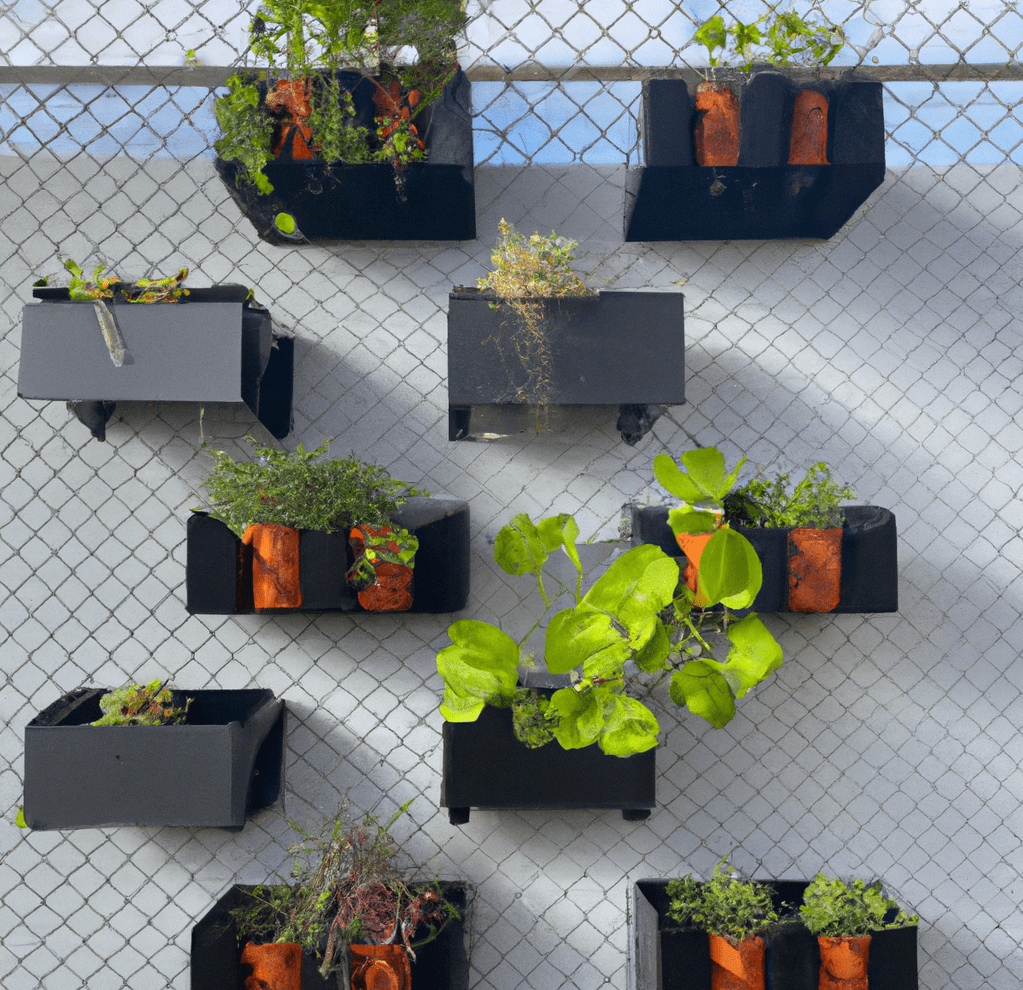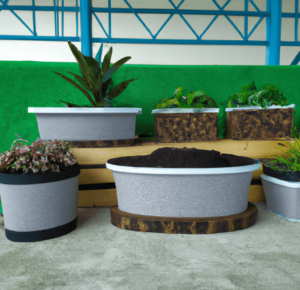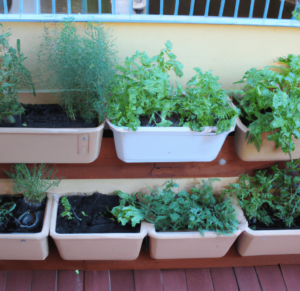People can develop a green atmosphere and a connection with nature through gardening. You may create a garden with a variety of plants whether you have a little balcony or a large backyard. Vertical gardening is a creative method to make the most of your gardening space and design a lovely garden in a little area. Instead of growing horizontally on the ground, plants are cultivated vertically, in stages or levels. This kind of gardening is a fantastic method to bring nature into your home, especially in cities with limited space. You may quickly and easily make a vertical garden with planters and benefit from growing your own plants. It’s simple to select the ideal planter for your gardening needs because they come in a variety of designs, sizes, and materials. They offer the soil, water, and assistance required to raise healthy plants and make a lovely garden. Planters also aid in regulating plant growth and maintaining the proper shape of the plants. Here’s what you need to know about using planters for vertical gardening!

Types of Planters for Vertical Gardening
There are different types of planters with unique uses to choose from when it comes to vertical gardening. Every type of planter has special qualities and advantages that make it appropriate for various plant species and gardening techniques. When you’re learning about using planters for vertical gardening, here are the different types to choose from:
- Hanging Planters: Trailing plants like ivy, ferns, and other vining plants flourish beautifully in hanging planters. These planters offer the ideal growing environment for plants that need to grow downward because they may be hanging from a wall, fence, or even a ceiling.
- Wall-Mounted Planters: Wall-mounted planters let you grow plants right on a wall, making them a popular choice for vertical gardening. These planters are available in a variety of sizes and shapes, and hooks or brackets can be used to mount them on any wall surface.
- Freestanding Planters: These are an excellent choice for people who wish to build a vertical garden in a particular section of their patio or garden. These planters are a flexible option for gardeners who wish to experiment with various garden ideas because they can be moved and relocated as needed.
The Different Types of Planters and Their Suitability for Different Plants and Spaces
When you’re designing a container garden and decide on using planters for vertical gardening instead, some planters are better suited for your need than others.
For instance, well-mounted planters are good for smaller, bushier plants that can climb vertically up a wall, but hanging planters are perfect for trailing plants that must grow downward. On the other hand, freestanding planters are a terrific option for larger plants that require more space to flourish and can also be used to build a raised garden bed.
It’s crucial to take your plants’ preferred degree of moisture into account when picking a planter. The type of planter you select should offer enough moisture to keep your plants healthy because certain plants require more moisture than others.
How To Choose the Right Planter
Now that you’re going to be using planters for vertical gardening, you want to choose the right planters. Think about the kind of garden you want to have and the plants you want to grow before choosing a planter. For instance, a hanging planter may be a fantastic option if you want to grow flowers, whilst a wall-mounted planter is perfect for growing small herbs or succulents.
The type of planter you use, such as plastic or wood, is also crucial to think about because it affects the soil’s temperature and moisture content. Additionally, ensure the planter has adequate water-draining holes to prevent overwatering and is big enough to house the plants you intend to cultivate. Overall, the success of your vertical garden can be greatly impacted by choosing the correct planter.
Size and Capacity
When learning about using planters for vertical gardening, the size and capacity of a planter are crucial considerations. You must make sure the planter you select has enough soil to support the growth of the plants you intend to grow and is big enough to hold their size.
A wall-mounted planter with a compact shape may be adequate for smaller plants and herbs. However, you might need to take into account a standalone planter or a raised garden bed for larger plants or a more significant vertical garden.
Think about how much space you have for your vertical garden and how many plants you want to grow when selecting a planter. To give your plants more support, you might also want to think about adding a lattice or trellis to your vertical garden.
Material and Durability
After learning about using planters for vertical gardening, it’s crucial to take into account the planter’s material and durability. The soil and the health of your plants might be affected by the varying qualities of various materials. For instance, wooden planters are more robust and offer better insulation but require more upkeep whereas plastic planters are lightweight and low-maintenance but may not provide enough insulation for the soil.
Drainage and Irrigation
Your vertical garden must have proper irrigation and drainage to be successful. The planter you select needs to have enough drainage holes to avoid waterlogging and encourage strong root growth. This is crucial for plants like flowers and herbs that are prone to root rot.
The irrigation system you’ll employ for your vertical garden is another thing to think about. While some planters have automatic irrigation systems built in, others need to be manually watered. Make sure the planter is accessible if you’re utilizing a manual watering method so you can give your plants regular watering after learning all about using planters for vertical gardening.

Design and Aesthetic
Your vertical garden’s overall appearance can be significantly influenced by the style and design of a planter. You may select a planter that best matches the design of your garden and the surrounding area because they are available in a wide range of patterns, colors, and materials.
For instance, a sleek and contemporary metal planter may be better for a contemporary garden than a wooden planter with a rustic style. To build a special and customized vertical garden, you can also select from a choice of hanging planters, wall-mounted planters, and freestanding planters.
Consider selecting a planter that matches the existing fence or wall if you want to integrate your vertical garden into a bigger garden or landscape. A planter that matches the hue of your plants or the nearby foliage is another option. This is important in using planters for vertical gardening.
Plant Selection for Vertical Gardening With Planters
It’s vital to think about the sort of planter you’ll be using, as well as the quantity of light, moisture, and space the plants will receive, when selecting plants for your vertical garden. It’s crucial to choose plants that will flourish in your specific location because different plant varieties have distinct growing requirements. Here are the best plants to choose after learning about using planters for vertical gardening:
- Vertical gardens are an excellent place to use climbing plants, such ivies and climbing roses. They can climb the wall and produce a rich, green backdrop, making them perfect for wall-mounted planters.
- Petunias and ferns that trail are excellent choices for vertical planting. Due to their ability to pour over the sides and produce a cascade of color and texture, these plants are ideal for hanging planters.
- Low-maintenance plants that work well in vertical gardens include succulents and cacti. These plants can grow in bright, sunny environments and need very little water, making them perfect for vertical gardens in hot or dry areas.
- Vertical gardens make it feasible to cultivate fresh food in constrained locations by allowing for the growth of herbs and vegetables as well. These plants can be a vital source of food for your family and are perfect for freestanding or wall-mounted planters
Considerations for Light, Temperature, and Humidity
It’s crucial to take your space’s lighting, temperature, and humidity conditions into account when you’re thinking about using planters for vertical gardening. It’s crucial to choose plants that will flourish in your particular environment because different plants have varying requirements for these environmental conditions.
For instance, if your vertical garden will be exposed to a lot of direct sunshine, you should pick plants that can withstand the heat. You should pick plants that are more tolerant of shadow if your vertical garden will only receive partial sunshine. As temperature and humidity can affect the health and development of your plants, it’s also critical to take these factors into account.
Setting Up and Maintaining a Vertical Garden With Planters
As you’re learning about using planters for vertical gardening, here’s how to set them up:
- Based on the light and temperature conditions, choose the best place for your vertical garden. Then, firmly fasten or mount the planters to the wall or fence.
- Carefully place your chosen plants in the pots after filling them with the required amount of soil. To promote wholesome development, use fertilizer and irrigation on a regular basis.
Irrigation and Fertilization Tips
The health and growth of your plants in a vertical garden depend on proper irrigation and fertilizing. When you’re learning about using planters for vertical gardening, here are some of our tips:
- Avoiding overwatering is crucial when watering because it can cause root rot and other issues.
- Make sure your plants get the correct amount of water by using a drip irrigation system or slow-release irrigation system.
- When fertilizing, pick a balanced fertilizer that is suitable for your plants and apply it in accordance with the directions provided.
- Consider utilizing organic fertilizers while growing herbs or other culinary plants to encourage flavorful, wholesome growth.
Your vertical garden may flourish and produce a plentiful crop with the right watering and fertilization.
Common Problems and Solutions
Although growing plants in a vertical garden can be challenging, with the right care, these obstacles can be overcome. Here’s what you need to know about issues you’ll face when: using planters for vertical gardening:
- One of the most frequent issues that gardeners deal with is overwatering.
- Other issues include poor lighting and pest infestations. Use drip irrigation or a slow-release irrigation system to prevent overwatering and stay away from watering your plants’ leaves.
- Consider moving your planters or adding grow lights if your plants aren’t getting enough light.
- Use natural approaches, such as companion planting, or introducing beneficial insects, such as ladybugs or lacewings, to control pest infestations.
You can keep your vertical garden strong and blooming by following these suggestions.
Bottom Line: Using Planters for Vertical Gardening
Increased growth space, less soil erosion, and better air and water movement for plants are just a few advantages of using planters for vertical gardening. Vertical gardening with planters is a productive and enjoyable way to raise plants, regardless of whether you are an experienced gardener or are just getting started.
You can choose the planter that best meets your needs and available space from a wide variety of planters, including hanging planters, wall-mounted planters, and freestanding planters. Consider variables including planter size and capacity, planter material and durability, planter drainage and irrigation, and planter design and beauty when choosing a planter. You may create a flourishing vertical garden full of herbs, veggies, climbing and trailing plants with the right planter and care.
Using Planters for Vertical Gardening FAQs
What is vertical gardening?
Growing plants vertically in tiers or stages as opposed to horizontally on the ground is known as “vertical gardening.” This is a great way to incorporate nature into your house, especially if you don’t have much room.
What are the benefits of vertical gardening?
A lovely garden can be made in a small space by using vertical planting to maximize your gardening space. It’s a simple and original method to incorporate gardening’s advantages into your home.
What kinds of containers are there for vertical gardening?
For vertical gardening, a variety of planters are available, including freestanding, wall-mounted, and hanging planters. Each style of planter has distinct characteristics that make it appropriate for various plant types and gardening methods.
What planter should I pick for my vertical garden?
Think about the type of garden you want to build and the plants you want to cultivate before selecting a planter for your vertical gardening. Consider the planter’s dimensions and capacity as well as its construction, sturdiness, drainage, and watering. Make sure the planter is large enough to hold the plants you wish to cultivate and take into account the desired moisture level for each of your plants.
What factors should I to take into account when picking a planter for my vertical garden?
Think on the kind of plants you want to cultivate, the planter’s size and capacity, its material and durability, the drainage and watering, and so on. In order to prevent waterlogging, make sure the planter has enough drainage holes and enough soil to sustain the growth of your plants.
What impact does the planter’s material have on my vertical garden?
The planter’s material has an impact on the soil’s temperature and moisture level, which can harm your plants. While plastic planters are lightweight and low-maintenance, they might not give enough insulation for the soil compared to wooden planters, which offer superior insulation but require more upkeep.
Are irrigation and drainage necessary for a vertical garden?
Yes, appropriate drainage and watering are essential for your vertical garden to succeed. The planter needs to have plenty of drainage holes to prevent waterlogging and promote healthy root development. If you intend to manually water the planter, make sure it is accessible and take into account the irrigation system you will use for your vertical garden.







